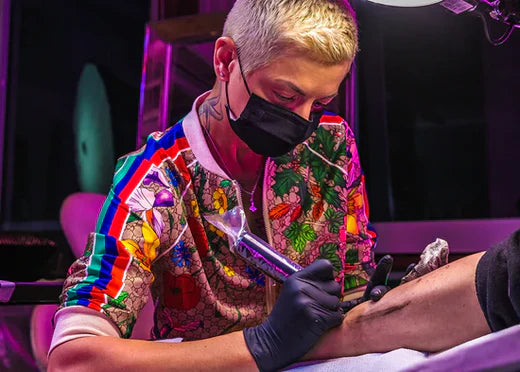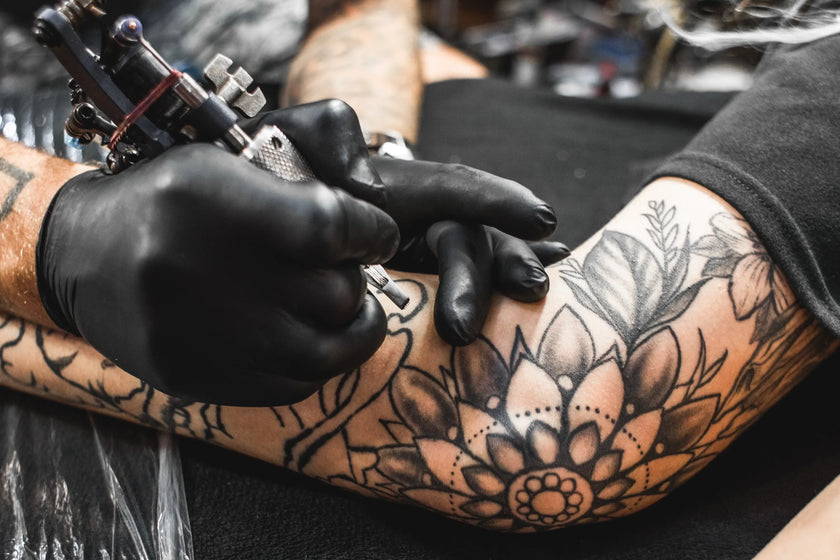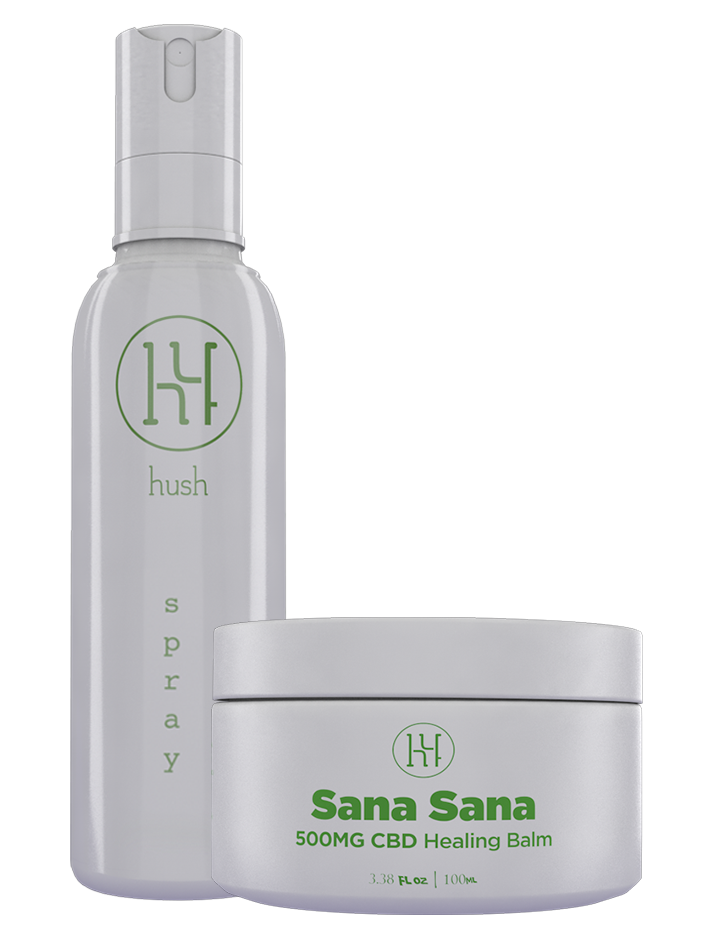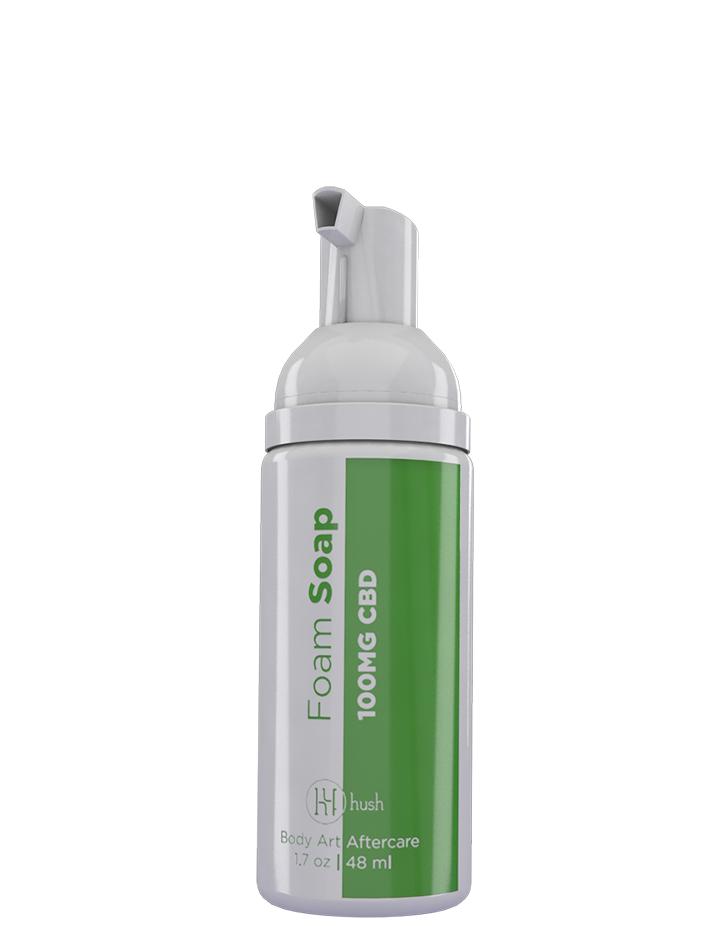Scabbing is the cocoon in which a caterpillar turns into a butterfly. (Yeah, we used the butterfly transformation metaphor on you.)
Tattoo scabbing can feel ugly, but if you let it work its magic, it’s going to make for a beautiful, healthy tattoo.
Scabbing is an important part of the tattoo healing process. Scabs keep bacteria out of your wound, protecting you from an infected tattoo and aiding the skin and nutrients underneath to heal properly.
Here’s everything you need to know, and stop picking at that thing will you!
What Are Scabs?
When you have a wound, it bleeds, and there are platelets in that blood. Platelets are little disc-shaped pieces of cells that help form blood clots.
What is a blood clot? It’s a formation of blood platelets, proteins, and cells that slow the flow of blood. When platelets come into contact with air, they churn out what looks like tiny threads, and catch a bunch of blood cells in the webs. These web-catching and blood-clotting processes form scabs.
So, scabs are basically a bunch of blood clots. That’s why they usually have that dark red-brown color. You just see the top portion of a scab but really it has a kind of iceberg situation happening.
A scab is a cap to a bunch of healing platelets, proteins, and cells doing work underneath to heal you. Scabs protect your wound from outside bacteria while also trapping the good stuff inside.
Why Does a Tattoo Scab?
The tattooed area of your body is a wound. A bunch of needles pricking into your skin thousands of times is going to cause a reaction from your body.
Your body starts the healing process by sending blood to the tattooed area — that’s why it’s normal if you bleed a bit during the tattoo process, and why it’s normal for your fresh tattoo and bandage to be a little bloody after the tattoo session.
The blood senses open wounds and starts moving into the wounded area filling it with healing agents. The blood that reaches the top of the wound, where the air is, forms scabs. That is what you are seeing on your tattoo.
When Does a Tattoo Scab?
You should start to see scabbing around 3-5 days from when you get your new tattoo.
Technically, scab formation starts right away with blood clots. The harder wound coverings we know to be scabs start taking place around the 3rd to 5th day after a fresh tattoo.
How Long Do Scabs Take To Fall Off Tattoos?
You will see soft clumps of “tissue” before the scabs harden into their final hardened form. The final scab can stick around anywhere from a few days to weeks later. The length of time you have a scab will depend on your biology, the size of the tattoo, the intensity of the tattoo, and your aftercare routine.
Bigger wounds have bigger, thicker scabs and more healing to do so they will take a longer time to heal.
Smaller wounds have tinier, thinner scabs, and less healing to do so they will take a shorter time to heal.
When a tattoo “falls off” naturally, that means the skin underneath is ready to take the stage. It won’t look perfect yet, but it’s on its way!
What Does Tattoo Scabbing Look Like?
Tattoo scabbing does look a bit different than regular scabbing. They will often take on the color of the ink used in your new tattoo, and where they form will depend on the linework in your tattoo.
Bolder linework means more needle pokes in the same place, which tends to create a more intense wound. Also, areas of solid, darker color are more likely to scab as it is also a more intensive wound.
Just think about it. When you have light line work or light shading, it requires fewer needles and fewer pokes in the same place. That means less of your skin is being damaged.
Bold line work and solid areas of color require more needles to deliver more ink and more pokes to make sure the area is solid and no un-tattooed skin is left. That means more of your skin is being wounded.
Tattoo scabbing is usually light. It isn’t going to form heavy scabbing the way injuries or surgeries do. Tattooed skin isn’t seriously wounded. It’s more of a mild wound. The scabs are light and tiny. Initially, they will just look like flaking or peeling skin.
What To Look for When Your Tattoo Starts Scabbing
Scabbing is a natural part of the tattoo healing process, but it’s important to understand what’s normal and what could signal a problem. There's a big difference between normal scabbing and abnormal scabbing. While normal scabbing can be a little gross to deal with, it's completely healthy. Just make sure things are going according to plan.
-
Light, thin scabs: These are normal and typically form within a few days. They help protect your healing tattoo.
-
No excessive peeling or cracking: While some flaking is normal, large cracks or heavy peeling may indicate that your skin is too dry or that your aftercare process isn't up to par.
-
No tightness or pain: Your tattoo may feel slightly tight, but it shouldn’t be painful. If it still hurts a few days after the appointment, that's not a good sign.
-
No signs of infection: Watch for redness, swelling, warmth, or discharge. These could indicate infection. It's best to see a doctor ASAP.
- Minimal itchiness: Mild itching is common as your skin heals, but avoid scratching to prevent damaging your tattoo. Remember, NO PICKING, NO SCRATCHING. JUST. DON'T. TOUCH. IT.
Aftercare instructions are designed not only to help your tattoo heal beautifully but prevent infections or other healing complications. If you're locked in and doing everything right, it's very rare to experience complications.
If you're worried that something isn't right, snap a picture and send it to your artist. If you know for sure that something isn't right, call the doctor.
Should You Stop Tattoo Scabbing?
Below your scab, skin tissues are regenerating. If you pick or remove your scab you are going to take some of those beautiful new tissues with it, impairing your healing process, so enough already with the picking!
Picking your scab can leave more apparent scars. When you pick a scab you are irritating the skin and leaving an open wound giving bacteria the chance to enter again. Inflammation and bacterial infection are a couple of reasons that some scars are more apparent than others.
Maybe you are usually a scab-picker and you don’t care about having potentially worse scars caused by scab-picking, but this time is different! This time you have chosen a piece of art you want on your body forever, and you paid for it.
A weird scab wasn’t part of the design you chose, and if you don’t want it to become a part of your new tattoo, then you better leave that scab alone!
Scabbed wounds fail to heal as well or at all compared to wounds with scabs because of their lack of protection.
What To Do If Your Tattoo Scab Is Itchy?
Itchiness is part of the healing process. Itching means your wound is healing properly. Well, not always always, but usually.
Itching signifies your skin is being stimulated. New skin growth stimulates the skin. Histamines, collagen cells, and a bunch of other bodily goods are tramping around on your wound and fixing you up.
Itchiness does not mean you should scratch! If you scratch, you could pull off the good, healthy skin and reveal the wound underneath, re-opening your tattoo to infection. If you haven’t been washing tus manos properly then you can also introduce bacteria to your skin by scratching.
Instead. use a soothing product like a healing spray, healing lotion, or even a numbing gel or cream (we bundled all that here to make it easy for you in these trying, itchy times). Try to soothe the itch and then go and distract yourself. Mind over matter makes for a happy and healthy tattoo!
If your scab is itchy and there is redness and oozing, that may not be the good type of itch. Get yourself to a medical professional to check if you have a tattoo infection.
What Happens When a Scab Falls Off?
That’s a great sign that your wound is healing properly. When a scab falls off, it leaves a thin layer of new skin underneath. This new skin usually looks a bit taut and maybe just a tiny bit red. It gives your new tattoo that initially dull look.
The skin underneath that new layer of skin is still healing but it is closed to the outside world thanks to your scab. The deeper skin, around the tattoo ink, will keep healing for the next 3-to 4 months and the new skin your body created is also going to settle in and start looking and feeling normal. Isn’t science cool?
Your tattoo will take about 3-4 months to completely heal and settle into its look. What does that mean for you? Tattoo aftercare continues past those first couple of weeks, so get yourself a good cleanser and moisturizer!
How To Help Your Tattoo Heal

Take care of your new tattoo during the healing stage by following your tattoo artist’s aftercare instructions and using tattoo aftercare products. Careful cleansing and meticulous hydration during the first week of your tattoo’s life is going to make for a happy tattoo and encourage a shorter healing time overall.
Wash your tattoo about twice a day and after any dirty activities. You want to keep it clean but you don’t want to wash it so much you are getting rid of the good stuff working to heal it. Wash your tattoo with clean hands, fragrance-free antibacterial soap, and warm water. Pat it dry with a paper towel and then apply a thin layer of an aftercare cream.
When your tattoo starts scabbing and peeling you may feel inclined to scrub it off while washing your tattoo – please do not. Need we remind you, that’s the good stuff! The scabs are as beneficial to your tattoo healing as you keeping the tattooed area clean. So work together here!
Once your tattoo has gone through the scabbing stage and is healed on the outside, you can start to use a lotion instead of an antibacterial moisturizer. You should also make sure you are applying SPF to protect that new skin and new tattoo from the sun.
Summary
Your tattoo loves scabs. Scabs form to slow the bleeding and form barriers between your healing tattoo wound and the outside world. They trap the good stuff in and keep the bad stuff out.
They might look crusty, but they are a good sign that your tattoo is healing well. You should only have to deal with them for a week or so and then they will fall off on their own.
No picking! Even if they get itchy!
It is usually a good sign if your scab is itchy. It means the skin underneath is healing and your scab will soon be gone. Give thanks and good riddance.
When it’s gone, the fresh skin underneath will be revealed, and below that is your tattoo. Give them some love with tattoo aftercare products. Cleanse, moisturize, and protect your new tattoo from the sun. AND NO PICKING!
Sources:
Definition of Platelet | NCI Dictionary of Cancer Terms
Definition of Blood Clot | NCI Dictionary of Cancer Terms
All About Scabs | Franklin Institute
The Molecular Biology of Wound Healing | PMC




